Soviet Spetsnaz Guns, Part II
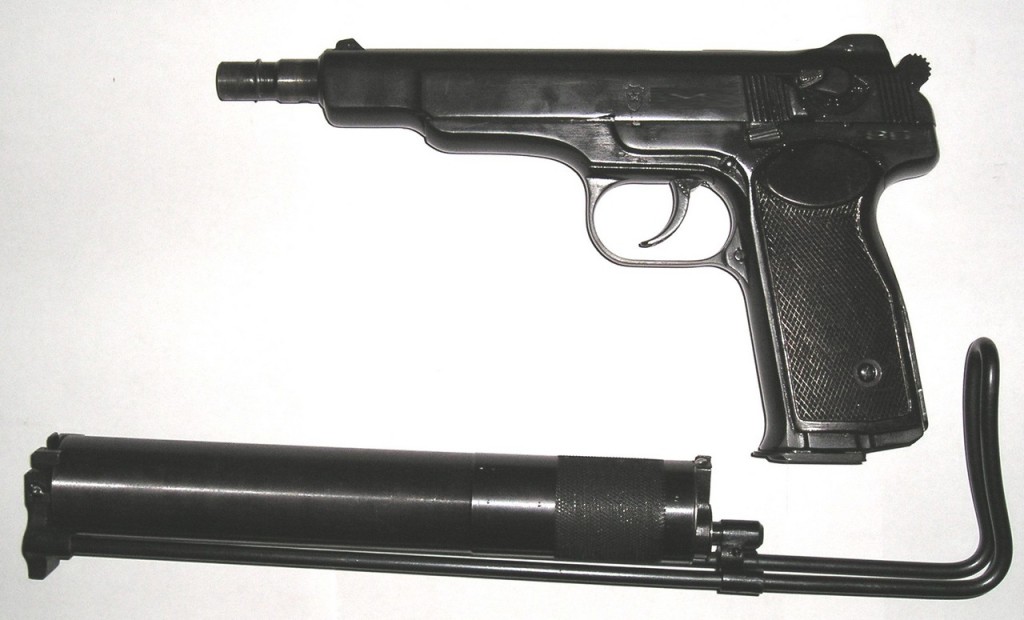
As discussed in a previous article on the PB pistol, Soviet Spetsnaz troops played a key role in Soviet military doctrine, in both local operations (mostly in third world countries such as Afghanistan) and in possible global war in Europe. In either case, Spetsnaz required, among other things, weapons that could be used with at least some degree of stealth. The silenced 9×18 PB pistol, described before, was the first ‘mass issue’ Spetsnaz silenced handgun. It was quite effective, but Spetsnaz was always on the look for the more firepower, and one of the requests was for a weapon to match (at least partially) the western silenced 9mm submachine guns, such as Sterling L34A1 and others.
At the time Soviet tactical doctrine had no place for submachines gun at all, and the closest thing in Soviet arms inventory was the 9mm Stechkin APS machine pistol. Many thousands of these guns were produced in USSR during mid- to late fifties, and by the early seventies most were replaced by Kalashnikov assault rifles, withdrawn from service and put into storage. This large pistol featured a 20-round magazine, detachable holster / shoulder stock and a selective-fire mechanism with rate reducer, which permitted for controllable rate of fire of about 600 rounds per minute. Effective range, with shoulder stock attached, was up to 70-100 meters (although the sights were optimistically marked up to 200 meters). Holstered, this weapon was certainly more compact than most of the contemporary western submachine guns, although wooden or plastic holster / shoulder stock added significant weight to the gun itself.
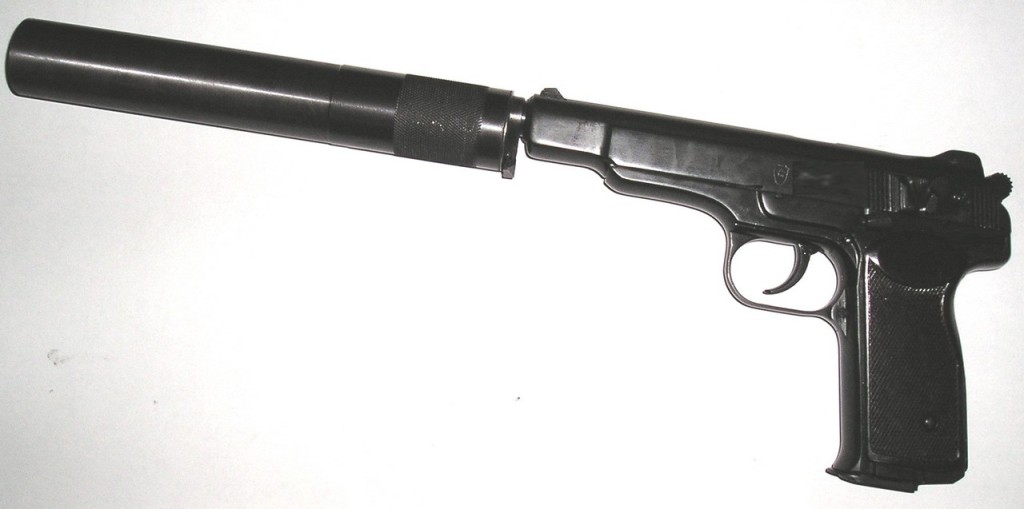
The task of designing a silenced version of the APS was handled to TsNII TochMash (Central Scientific Research Institute of Precision Machine building), the key design bureau for various Spetsnaz equipment. Development team was led by designer Neugodnov, and modified weapon was provisionally marked AO-44. After mandatory tests and evaluation this weapon was officially adopted for use by Soviet Army in 1972, as “Avtomaticheskij Pistolet Beschumnyj APB” – automatic noiseless pistol, official military index 6P13. All APB pistols were remanufactured at TsNII TochMash from old APS pistols, and thus bear manufacturing dates from late 1950s. These pistols were widely used by Soviet Spetsnaz in Afghanistan, and are still in limited issue with military and law enforcement of Russia and certain other ex-USSR states, although most were retired from service due to their age, and replaced by more effective and modern weapons.
The author had the chance to fire APB at a Russian military installation, and was quite impressed with it. The heavy pistol, with addition of the large silencer, handles already mild recoil of the 9×18 cartridge quite well, in both semi-automatic and full automatic modes. Due to the built-in rate reducer, two- and three-round bursts are easy to master; even single shots in full-automatic mode are easy to obtain with minimal practice. The single-shot accuracy at 25 meters was hard to judge due to the age of the gun and the well-worn barrel, but it was generally acceptable. In full-automatic mode and at 25 meters, when using standard wire shoulder stock and two-hand grip (both hands holding the pistol grip), the author was able to put 3-4 round bursts into an area 4 to 6 inches in length (with hits spreading mostly in vertical direction). With left hand holding the silencer of the gun (with proper heat insulation provided by the piece of cloth wrapped around it) the vertical spread in short bursts can be further decreased by about 30%.
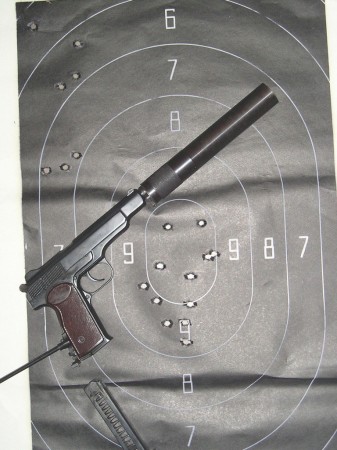
The sound of the firing is mild and roughly similar to that of powerful air-gun or .22LR rifle, although the slide slams back and forth with loud metallic sound. The wire stock, supplied with APB pistol, is significantly lighter and more compact than the wooden stock-holster of original APS, but the latter provides a better control over the weapon, at least by the author’s own impression. Unfortunately, no special holster was available for APB at the time of informal test, but almost any holster would be more comfortable to carry than the original wooden or plastic holster / shoulder stock of APB. In the field, the gun was carried in the leather flap-type holster, with integral pocket holding shoulder stock with silencer attached to it. Spare magazines were carried in double leather pouch, with two pockets each holding two magazines. Standard ammunition load for each APB issued for combat was 100 rounds (one magazine in the gun and four spares in pouch on the belt).
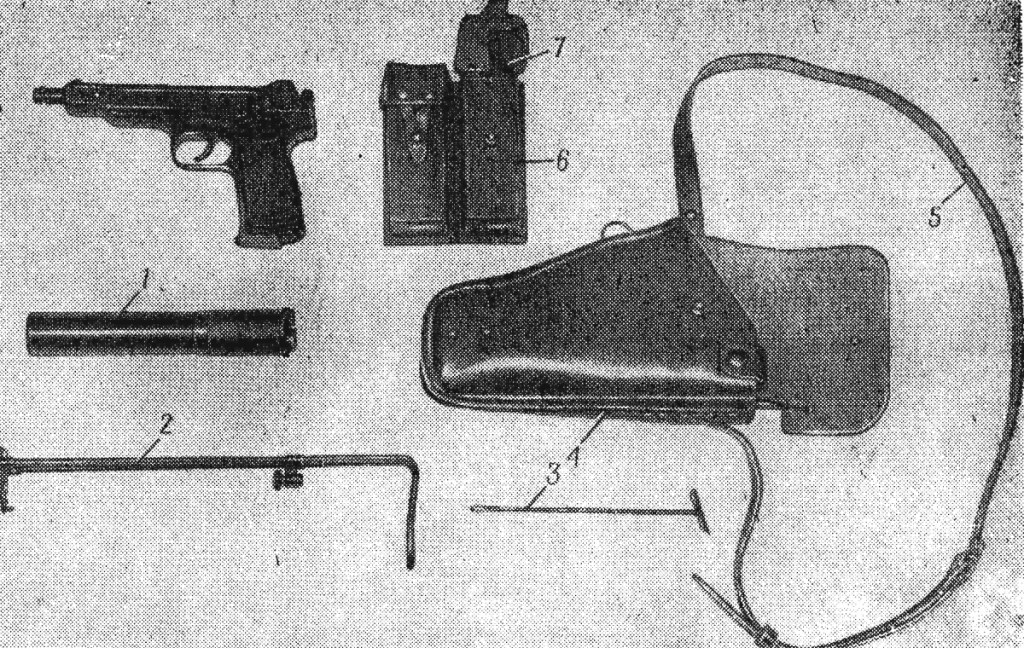
The Stechkin APS pistol, which served as a base for APB, could in some respects be considered the first “Wondernine” – the high capacity, double action, nine-millimeter caliber pistol. Also, in some respects, it was still influenced by the pre-war machine pistols like the Mauser C96 Schnellfeuer, Astra Modelo F or Star MM. All considered, when originally issued it failed to fill a predetermined niche of Personal Defense Weapon for frontline NCOs and vehilcle crews, as it was too bulky and heavy for a pistol, and too weak for a carbine or sub-machine gun, still less an assault rifle.
The APB pistol is blowback operated, with a fixed barrel. To achieve subsonic velocities under all environmental conditions and with a relatively long barrel (APS barrel was 140mm (5.5 in) long and accelerated standard 9×18 bullet to transonic velocity of 340 m/s – (1115 fps)), the barrel of the APB is ported. Two sets of radial holes are drilled, one near the chamber (four holes) and another about an inch from the muzzle (two rows of eight holes total). The barrel is then enclosed into a removable steel tube, which directs the excessive powder gases forward to the muzzle, and protects the internals of the gun from hot gases and burnt residue. This tube extends forward from the muzzle of the barrel for about an inch, to provide necessary mounting interface for quick-detachable silencer. This interface consists of a single turn of the thread, made on the outside of tube. Since in original APS design the return spring was located around the barrel, a new return spring of larger diameter was manufactured, and slide was machined from inside to provide more room for the enlarged diameter spring. During disassembly, the tube can be easily detached from the barrel once the slide and return spring are removed; this is necessary for routine cleaning and maintenance of the gun, although the gun examined by the author was probably not cleaned for years, yet ran flawlessly.
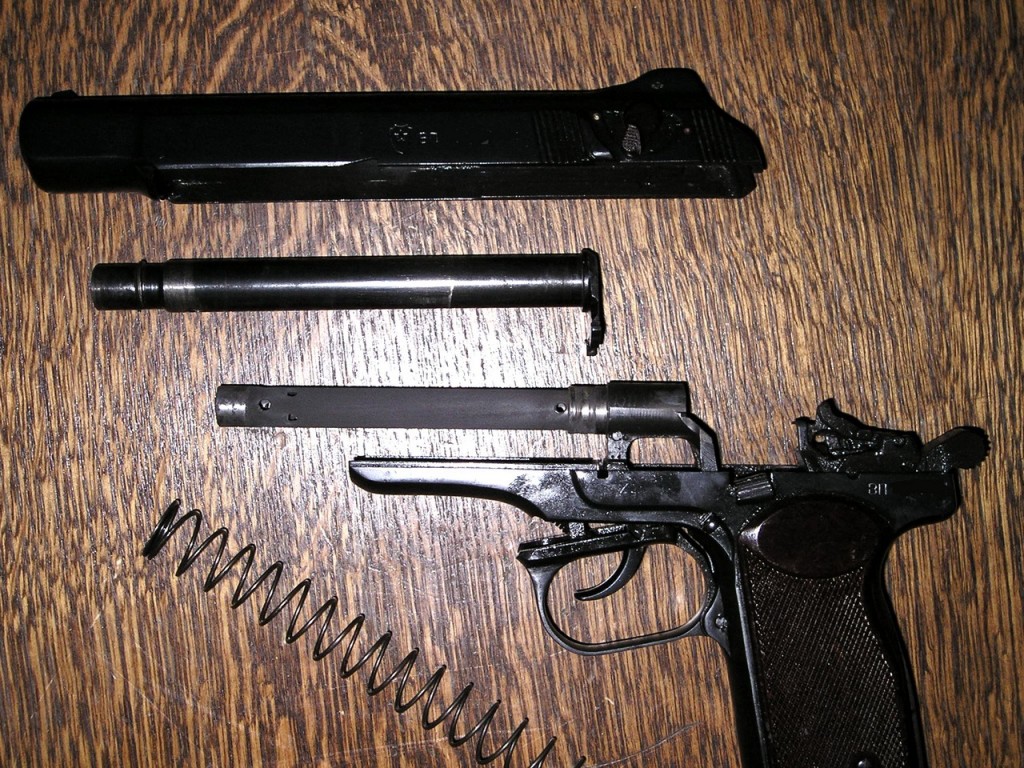
The trigger is double action, with an exposed hammer; a three-position safety works as a fire mode selector (safe – semi – auto), and also forces the hammer to de-cock safely when gun is set on “safe”. To provide controllable full automatic fire, the APB is fitted with an inertia-type rate reducer, made in the form of a steel plunger that reciprocates up and down in the grip, just behind the magazine channel. When the pistol is fired in full automatic mode, at the end of its forward movement the slide hits the plunger and forces it down against its spring; at the same time, the hammer is held cocked by the automatic sear. Once the plunger completes its down-and-up cycle, it strikes the automatic sear and thus releases the hammer to fire the next shot. The magazine is of the double-stack type with a double feed, the magazine release is located at the base of the grip. Sights are of somewhat unusual design, with a fixed front and a range-adjustable rear; rear sight adjustments are made by the rotation of a small drum, which has pre-sets for 25, 50, 100 and 200 meter ranges. The grip is slotted, originally to accept shoulder stock / holster, which in APB version was replaced by detachable steel wire stock. The stock has spring-loaded clamps, which are used to attach a silencer to it for storage and transportation (see top photo).
The quick-detachable silencer is of a relatively simple and robust design. It consists of a steel tube, open at the rear, and a steel insert which runs entire length of the silencer, and provides mounting surfaces on the rear and holds four steel baffles at the middle and front. Baffles are permanently welded to the insert, so for all practical purposes silencer can be broken down to just two parts – outer shell and insert. To provide unblocked sight line with original sights, the silencer is of eccentric design, with most of its volume being moved downward from the axis of the bore. It is probably not the most effective design, but it is certainly robust, and can withstand rough handling and serve for years without any cleaning and maintenance. To protect the silencer from unscrewing itself through the use, it has a spring-loaded lock.
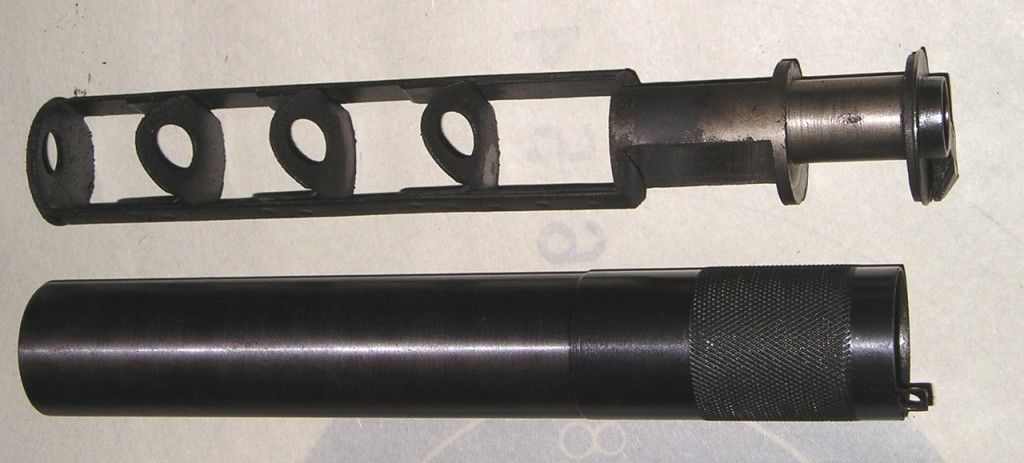
Manual safety
A lever at the left side of the slide. Rotate lever forward and up to turn the safety on; rotate it down about 60 degrees (position marked with a dot) to turn the safety off, in single shot mode; rotate it all the way back to set to the automatic fire mode. When applied, the safety blocks the movement of the slide and de-cocks the hammer automatically.
Field stripping procedure
- Remove the magazine by pressing the magazine release button;
- Check that the chamber is empty;
- Pull the trigger-guard downwards, then swing it to one side to lock it in the open position;
- Pull the slide all the way back, then raise the rear of the slide to the top, and off the frame rails;
- Carefully ease the slide forward and off the barrel;
- Remove the return spring from the barrel;
- Rotate the gas evacuation tube left or right for ¼ of a turn, then pull it forward and off the barrel.
Reassemble in reverse order
Technical Specs
Caliber: 9x18mm PM
Locking mechanism: Blowback (unlocked)
Muzzle velocity: 950fps (290m/s)
Weight, unloaded w/o accessories: 2.4lb (1.1kg)
Weight, unloaded with wire stock and suppressor: 3.5lb (1.6kg)
Overall length, pistol only: 10.1 in (257mm)
Overall length, with suppressor and stock extended: 30.7 in (780mm)
Barrel length: 5.5 in (140mm)
Magazine capacity: 20 rounds

Do you have a video of this on youtube? I got to shoot one about a year ago and it was as smooth if not smoother than when I fired a Glock 18.
Nope – I haven’t had the chance to shoot one yet myself.
Has anybody seen these for sale?
Doubt any of them were imported.
As far as I know, these were never imported to the US. I can’t personally speak to the veracity of these claims, but I’ve heard from a friend of mine who was stationed in Germany for a little while during his time in the military that these are available to purchase for civilians (albeit in incredibly limited numbers) in a few areas of Europe, neutered to semi-automatic only operation. Supposedly even neutered these pistols can’t be imported into the US owing something to the design of them, though I’m not sure on the particulars. Rumors from a friend, so take with a grain of salt. I’d love to get my hands on one, even if it’s only semi automatic, I just love the looks of these pistols, and I’ve been a fan of 9x18mm ever since I purchased an old PA-63 off a customer of mine a few years back
Some of these guns were imported in France. There is frequent adverts for it in a magazine I read.
They are usually sold complete with leather holster, 2 magazines with leather pouch, steel wire stock and silencer.
Tokarev TT33, APS Stechkin and some others military pistols of USSR are quite common in firearms shops of France since two or three years. I don’t know anybody that have one (A man I talked with, a Swiss, had a 5,45×18 russian little pistol, but nobody else), though, and they don’t seem to be appreciated by French shooters, although russian weapons in general (espacially hunting rifles and .22 carbines) are common and greatly appreciated
APS can be considered first “wondernine”. LOL famous russian obsession with being first :)))) “wonder nine” refers to a 9×19 handgun so no APS can not be considered as a first wonder nine. sorry for ruining your day.